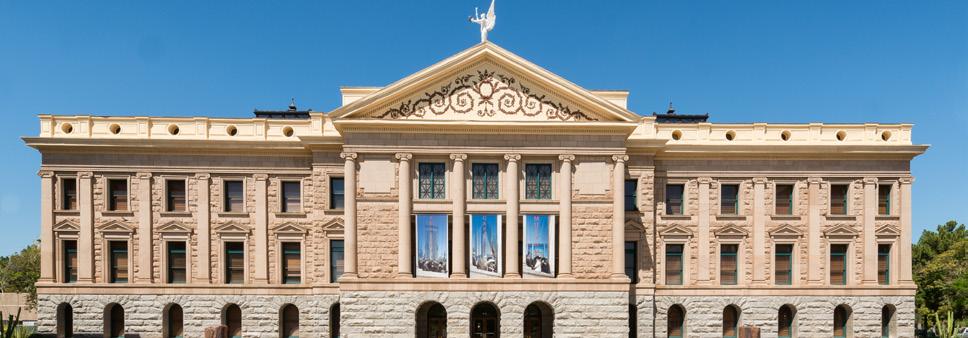
3 minute read
Election night shake ups bring new faces to office
By Jake Hinman and Bastien Andruet
Right on the heels of a contentious and unexpected primary election season, the state wasted no time in pivoting to the November General Elections.
Advertisement
With shake ups at both the municipal and legislative levels, many races began to set the tone in August for the long-awaited presidential race. Record numbers of new voters – over 230,000 – registered to vote by the Oct. 5 deadline, with both parties doubling down on their registration after a court decision extended the deadline to Oct. 23. While the presidential race consumed most of Arizona’s attention this year, it was the down-ballot races that arguably held even greater significance for Arizona’s political future. While “politicos and pundits” predicted a Democratic flip of the Legislature and many local seats this year, the settling dust and trickling results painted a different picture..
Election night turned into election fortnight
The 2020 presidential election will certainly go down in history for the country and here in Arizona. Though the Presidential race tightened in Arizona as President Donald Trump came within striking distance of his challenger, Joe Biden was able to secure the state for the Democrats for the first time since Bill Clinton in 1996. Former astronaut Mark Kelly received the most votes of any candidate in the state, nearly 100,000 more votes than incumbent U.S. Sen. Martha McSally, for his victory. While Democrats were ahead early on election night, the long-anticipated “blue wave” was reversed the following morning by what came to be known as the “red dawn.”

In Congressional District 6, for example, Congressman David Schweikert came back from a 30,000-vote deficit, securing his seat for a sixth term. Similarly, in Congressional District 1, incumbent Tom O’Halleran was able to narrowly fend off Tiffany Shedd by a mere 12,000 votes to secure another term, and the Democrats’ majority in Congress. Arizona has long been considered a Republican stronghold, especially when looking at the Arizona legislature.
For decades, the state Capitol has been strongly controlled by the GOP. In fact, Democrats have not controlled the Arizona House since 1966, and the Arizona Senate since 1990 (in 2000 the Senate was split evenly between Republicans and Democrats). Many predicted that both the House and possibly the Senate would “flip” in 2020 due to the changing demographics in the state.
But those predictions turned out to be wildly incorrect. While early returns indicated a strong showing for Democratic candidates, as the days wore on and as ballots were counted, Republican House and Senate candidates made a strong finish in their respective races. In the end only one Republican seat was lost in the Arizona senate. In the House both the Republicans and Democrats each lost a seat resulting in both chambers remaining in GOP control.
Arizonans also weighed in on two significant ballot propositions in November. Prop. 207, legalizing recreational marijuana, was overwhelmingly approved by voters. Prop. 208, increasing income taxes to boost education funding, narrowly passed with less than 52% of the vote in support.
Local elections brought new faces to city halls
The City of Scottsdale elected David Ortega to be the city’s new mayor, along with Tom Durham, Betty Janik, and Tammy Caputi (AMA endorsed candidate) as the three new city council members.
With four new faces, time will tell what direction the new leadership will take the city. The City of Phoenix held its primary election in November. To nobody’s surprise, Vice Mayor Kate Gallego and Mayor Betty Guardado (District 5) both received well over 60% of the vote and secured re-election.
In Council District 1, AMA endorsed, Ann O’Brien defeated former councilman Dave Siebert. Two other AMA-endorsed candidates, incumbent Debra Stark (District 3) and newcomer Cinthia Estela (District 7) have moved on to a March runoff election.
Looking forward
With many new faces at the Capitol and in city halls, it is hard to anticipate what the AMA will be facing this upcoming session. One thing that will be at the forefront of the AMA’s legislative agenda, however, will be the push for more affordable housing development.
The AMA and other housing stakeholders, working with state Representative Jeff Weninger (LD17), almost reached the finish line last year to establish a state Low Income Housing Tax Credit (LIHTC).
Though it passed with wide bipartisan support in the state House, the COVID pandemic prematurely ended its passage through the Senate. With housing at the forefront of both state and national politics, once can hope that this will be the year a state LIHTC program is finally established.

Jake Hinman is the Director of Government Affairs for Capitol Consulting.
He can be reached at 602-712-1121.

Bastien Andruet is a Municipal Lobbyist for Capitol Consulting.
He can be reached at 602-712-1121.





